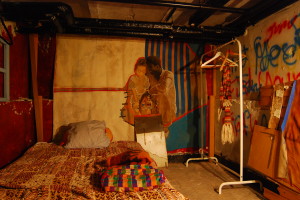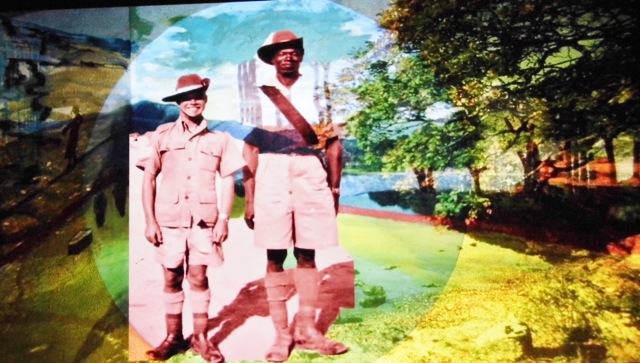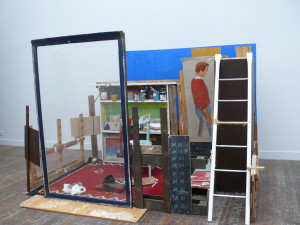
Marijke Everts, installation, 2014.
GALLERY 23, Contemporary African Art
Opening A SPACE BETWEEN & ARTISTS DINNER October 19
A multimedia, duo presentation of Marijke Everts and Helen Hintjens
@ SBK Amsterdam KNSM
Opening Sunday October 19, 17.30. Bernard Akoi-Jackson opens. Everts and Hintjens are present.
A SPACE BETWEEN CULTURES
An installation by Marijke Efua Everts and Helen Hintjens
It was more or less a coincidence that Helen Hintjens and Marijke Efua Everts even met. They were in the same Art Academy – the Royal Academy of Fine Art in the The Hague (KABK), but Helen was part-time and studied in the evenings, whilst Marijke did a full-time Fine Art degree and studied in the day. When they finally met, just before their final exam and graduation exhibition, not only did they find they had a shared, mixed background with some similarities; they had also each struggled for years with their teachers, some of whom could not relate to the non-Western elements in their artwork. Each was obliged to fit in with what was expected.
 Helen Hintjens, 2014 (film)
Helen Hintjens, 2014 (film)
Their determination, and their diverse backgrounds anchored both in Europe and in Africa, have resulted in this surprising, highly personal combined installation work, The Spaces Between.
Marijke Efua Everts has a Ghanaian mother and a white Dutch father. The family relocated regularly when she was growing up, since he worked for an international organization. Everts lives in Senegal and Italy, among other places, and then also in Ghana and The Netherlands. Although she now masters five languages, Everts never learned her mother’s birth language properly. As a consequence, the notion of ‘home’ has never had much meaning for her. She felt that she had to live in the ‘spaces between’ different cultures, and this on-going search fora feeling of belonging and identity became a major theme in her work.
 Marijke Everts, Installation, 2014.
Marijke Everts, Installation, 2014.
In her work she tries to explore the content of ‘home’ or ‘a sense of home’ in material form. Her installations give a spatial sense of a room, spaces for living in, spaces that literally look like somewhere for living in. These spaces are constructed from mostly found and recycled materials. Often these come from the location where the installation is built up, since Everts likes to work with the specific location in which she finds herself. Sometimes the materials are literally pulled out of the rubbish. She likes the idea that other people have already used these material at least one, and that after the exhibition, others can use these materials again. In this way she challenges the idea, common in Western art, that artworks should endure. In the rooms that she creates, she hangs up her own paintings, which become part of the furniture of the ‘home’ she makes. These paintings combine collage with paintings. They are put together with images from other sources. When combined, her installations combine elements of remembered fragments, abstracted and oriented towards a sense of the universal. Everts seeks to avoid making her installations too literal, or too personal. She wants to present her personal themes, but as a general, wider artistic form of expression, since she feels that many people can relate with the themes she is exploring. Her artwork is more than a ‘substitute home’; it is a state of mind expressed in material form, and the viewer is invited to identify with what they see, and with what surrounds them.
 Helen Hintjens, 2014 (film).
Helen Hintjens, 2014 (film).
Helen Hintjens’ father is Flemish and her mother is Scottish. Since the early 1960s, the family lived in various countries in the African continent, including in former Belgian Congo shortly after Patrice Lumumba was killed in January 1961. She also lived with her family in Kenya and Tanzania, and speaks some Kiswahili. She teaches at the International Institute of Social Studies in The Hague. Her perceptions of her diverse background differs significantly from that of Everts. First, because she is white, and thus placed on the ‘other side of the line’ of colour, and also because she is older and has perhaps had time to reflect and take some distance from the events. She is also more interested in theorizing the colonial history of Europe, and finds it essential to look at this history as something shared, something common. In her work she seeks to bring out the layered quality of this shared history, and its multiplicity, and “to let the colonial past filter through into the present day”.
The multi-layered quality of the shared history of Europe and Africa is what she tries to make visible in her work.
She does this by combining photos, film, painting, installation elements and collage. She recently started to make large wall-paintings, onto which she would project images, whether using slides or a beamer. The images were photographed and printed, or painted onto canvas. The collages and paintings can have a life of their own, as well as being part of the installation. Some of the images she uses are from others, for instance the work of David Roberts a famous war photographer, of Mau Mau in colonial Kenya. She translates these images, and mixes them with her own paintings. It is important for her that the layers of the images are visible as layers, and remain so. This gives the work more depth and gives them a more interesting, intriguing form. This visible layering also expresses the idea that the past and present are mixed up in one another. Here and there, then and now; it is central to her work that these are not separate, but overlapping. Whilst aesthetic, visual qualities may play a less central part in Marijke Efua Everts work, a search for the aesthetic is consciously or unconsciously motivated for Helen Hintjens. She wants her images to seduce you, so they can also shock.
What arises from their collaboration of these two artists, is not yet clear as I write. This will be decided in the location, and will come together shortly before the opening of the exhibition. Congeniality, mutual respect and their quirky use of materials, is likely to create a challenging and exciting exhibition.
The artist/writer Bernard Akoi-Jackson will also be present at the public presentation of the exhibition on 19 October, and will give his response to the work. As a part of the Global Collaborations program, Bernard Akoi-Jackson has recently been invited as artist-in-residence at the Stederlijk Museum in Amsterdam, where he will be working till the end of October 2014.
Rob Perrée
Amsterdam, September 2014.
Trans. Helen Hintjens
SBK KNSM
12 oktober – 12 november 2014
KNSM-laan 307-309
1019 LE Amsterdam
Tel 020-620 1321
DIRECTION
tram 10, stop Azartplein,
bus 48 from Sloterdijk en CS,
bus 65 from stations Zuid en Amstel
